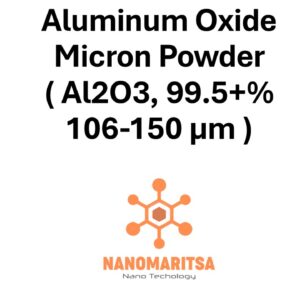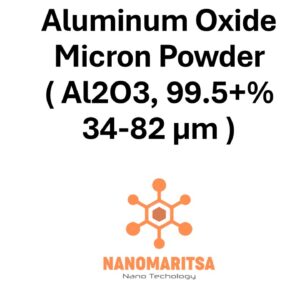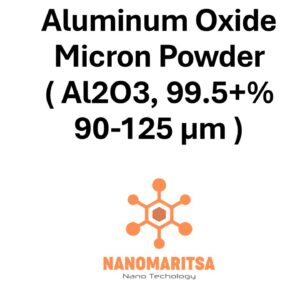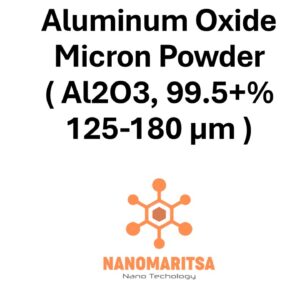Aluminum Oxide Micron Powder (Al₂O₃, 99.5+%, 16–49 µm) is a high-purity alumina powder valued for its superior hardness, thermal stability, and chemical inertness. With a particle size range of 16 to 49 micrometers, this powder is optimized for applications requiring coarser particles, such as powder metallurgy, abrasives, and protective coatings. Its 99.5+% purity ensures consistent and reliable performance in demanding industrial environments, making it a versatile material for aerospace, automotive, electronics, and manufacturing applications.
1. Key Properties
High Purity (≥99.5%) The high purity level minimizes contamination, ensuring reliable performance in advanced ceramics, coatings, and industrial applications.
Particle Size (16–49 µm) The coarser particle size enhances flowability and packing density, making it suitable for powder-based manufacturing and high-efficiency coating processes.
Exceptional Hardness With a hardness near 9 on the Mohs scale, alumina is ideal for wear-resistant applications, including abrasives, grinding tools, and protective coatings.
Thermal Stability Alumina’s melting point above 2,000 °C allows it to maintain structural integrity under extreme temperatures, making it a reliable choice for refractory applications and thermal barriers.
Chemical Inertness Resistance to acids, alkalis, and most chemicals ensures durability in harsh and corrosive environments, such as chemical processing or filtration systems.
2. Applications
Advanced Ceramics & Refractories Alumina is integral to the production of high-performance ceramics and refractory materials, such as kiln furniture, nozzles, and industrial components requiring high wear and heat resistance.
Abrasives & Polishing The 16–49 µm particle size is ideal for grinding wheels, cutting tools, and polishing media, delivering efficient material removal and high-quality surface finishes.
Thermal Barrier Coatings Alumina-based coatings protect engine components, turbine blades, and industrial furnaces from extreme heat, oxidation, and particle erosion.
Electronics & Insulation Alumina’s electrical insulating properties and thermal conductivity make it a preferred material for substrates, circuit boards, and protective housings in electronic devices.
Catalysis & Filtration High-purity alumina supports catalytic reactions and is used in filtration systems requiring thermal and chemical resilience, such as in petrochemical and environmental processing.
3. Advantages
Improved Flow Characteristics The coarser particle size enhances flowability, reducing clogging and ensuring uniform feeding in powder-based processes like sintering and thermal spraying.
Wear & Abrasion Resistance Alumina’s extreme hardness extends the service life of tools, coatings, and components exposed to abrasive or high-friction conditions.
High-Temperature Endurance Alumina retains its mechanical and structural properties at elevated temperatures, making it suitable for refractory linings, thermal barriers, and high-temperature manufacturing processes.
Chemical Stability Resistance to aggressive chemicals enhances the longevity of alumina-based components in industrial filtration, chemical processing, and environmental applications.
Electrical Insulation Alumina’s dielectric properties make it indispensable for insulating components in high-voltage or high-temperature electronic systems.
4. Recent Trends and Research
Additive Manufacturing Research into using coarser alumina powders in 3D printing processes, such as binder jetting and direct energy deposition, is opening new possibilities for complex ceramic parts.
Advanced Coating Technologies Innovations in plasma spraying and thermal spray methods are improving the durability, adhesion, and uniformity of alumina-based coatings.
Enhanced Abrasive Performance Efforts are focused on optimizing alumina abrasives for more efficient cutting, grinding, and polishing in industrial and precision applications.
Sustainable Practices Recycling alumina from used abrasives and ceramic waste is gaining traction, reducing environmental impact and supporting more sustainable manufacturing practices.
Energy Applications Alumina’s role in energy storage systems, catalysis, and filtration is expanding as industries seek cleaner, more efficient technologies.
5. Future Prospects
Next-Generation Ceramics Advances in powder processing and sintering will enable the production of more complex, high-performance alumina components for aerospace and industrial use.
Thermal Barrier Innovations Alumina’s ability to withstand extreme temperatures will drive its adoption in advanced coatings for engines, turbines, and energy systems.
Bioceramics & Medical Tools Alumina’s biocompatibility and wear resistance make it a candidate for medical implants, surgical tools, and dental devices with improved performance and longevity.
Lightweight Structural Materials Alumina-reinforced composites are expected to play a larger role in automotive and aerospace applications, offering high strength-to-weight ratios.
Environmental Solutions Alumina will continue to be pivotal in clean energy systems, filtration technologies, and catalysis, supporting global sustainability initiatives.
With its 99.5+% purity and 16–49 µm particle size range, Aluminum Oxide Micron Powder (Al₂O₃, 99.5+%, 16–49 µm) is a durable, high-performance material for diverse industrial applications. From advanced ceramics and abrasives to protective coatings and electronics, alumina’s unique properties ensure its continued importance in cutting-edge manufacturing and engineering.
| Measurement (gr) | 100 grams, 500 grams, 1000 grams |
|---|






